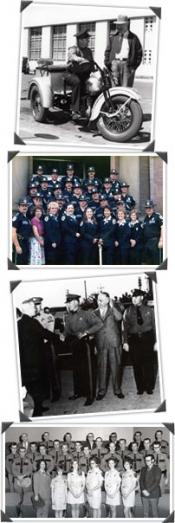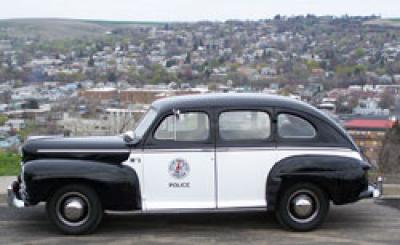History of the Pendleton Police
The City of Pendleton and the Pendleton Police Department has a long and proud history. We are honored to share that history with you.
The City of Pendleton had its beginning in the early 1860's when Moses Goodwin purchased land from a squatter for one span of horses. In 1868 the Umatilla County Court (established six years earlier) had a three-member selection committee to determine a site for the County Buildings. The site selected was between Birch and Wildhorse Creek to be named Pendleton in honor of Senator George H. Pendleton of Ohio (1864 Vice Presidential candidate for the United States). In December of that year, Moses Goodwin and his wife deeded 2 1/2 acres of land to the county from which the original town was plotted on December 18, 1868.
Pendleton was officially incorporated on October 25, 1880, with a population of 730 inhabitants. The early days found the citizens of Pendleton involved in many construction activities. A City Hall was constructed in 1908. The Umatilla River levy, and the water transmission line were completed around 1915.
The early Council minutes and ordinances reflect the colorful history of Pendleton. The first ordinance of the City dealt directly with drunkenness in public places, fights, and discharging of guns within the City limits. There are also accounts in the City Council minutes about Council members having to wade through knee deep mud and sewage from the inadequate septic tank drainage within the City. These major public works problems were overcome through the concerted efforts of citizens and through many trips by the Mayor of Pendleton to Salem to encourage the State legislature to allow the City to increase the debt limits of the City.

With the construction of a City Hall at 34 SE Dorion Avenue in 1908, all City services including the Police and Fire Departments and the School District were centralized in one structure. This close working relationship continued into the early 1950's at which time the School District moved to its own administration offices. City Hall then housed the administration offices, water department, police department and fire department. Later the fire department relocated to two manned fire stations, one on S.W. Court Avenue and the other on Southgate. A third station is located at the airport providing flight stand-by services. The Police Department moved to 109 S.W. Court Avenue in 1990. In April 2010 the Pendleton Police Department moved to its current location at 622 Airport Road.
In 1910 local attorney Roy Raley, who had an excellent flare for theatrics, decided to have a rodeo after harvest and the famous Pendleton Round-Up was born. The show was such a success that property was purchased and permanent buildings and grounds were constructed to hold the annual event. The slogan "Let'er Buck" was adopted as the Round-Up byline. The traditional event is held annually in the second week in September and now draws over 50,000 spectators and visitors to Pendleton. Additionally, the Happy Canyon pageant under Mr. Raley's direction started as the "night show".
We are adjacent to the Umatilla Indian Reservation. In May, 1855, five Indian tribes of Eastern Oregon and Washington territory met in Walla Walla to make a treaty with government officials. That treaty is known as the Treaty of 1855 and resulted in the formation of the Confederated Tribes of the Umatilla Reservation.
Pendleton, like many communities in Oregon, was hard hit by the depression of the 1930's. During the depression, City employees took a cut in pay and the situation became so desperate that the City printed and issued scrip to be redeemed at local stores by City employees. Apparently the scrip was very successful since it appears the City somehow made money during the period it issued the scrip.
World War II brought a great deal of development to the Pendleton airport. Runways were expanded, housing added, a sewer and water system established, all to prepare for the training of American pilots who served overseas. Jimmy Doolittle Raiders trained at the Pendleton airport. Many of the structures and improvements built during the war are still visible at the airport today. The airport and surrounding property was turned over to the City after the war and now houses the Eastern Oregon Regional Airport.
A major change occurred in the City's organization in 1948 when the community adopted a Council/Manager form of government. Since 1948 there have been eleven City Managers. The Council/Manager structure provides that all City employees work for the City Manager and the City Manager works for the City Council. The Council/Manager form of government assumes municipal operation can be run like a business and the City Manager serves as the general manager of this business. All City residents are encouraged to attend City Council meetings, which are the first and third Tuesdays at 7:30 p.m. and are held at City Hall.
In September, 1994 voters approved a $2.95 million general obligation bond issue to convert the Helen McCune Junior High School to a City Hall and Library. The City relocated to the building during November, 1996. The City Hall at 34 SE Dorion Avenue was sold for private development. The Carnegie building which housed the Library at 214 North Main was leased to the Pendleton Arts Council.
The relocation of the City Hall to the former Helen McCune Junior High Building brings a strong community emphasis to the 400 and 500 blocks of SW Dorion Avenue. The structures include the Vert building, City Hall, Public Library, and the Recreation Center Gymnasium. There are community meeting rooms and the Council Chambers/Municipal Court Room housed at this location.
The City of Pendleton, as a municipal corporation, has a proud history in terms of the service levels provided to our citizens. The services of ambulance, library, planning, police and fire protection, parks, water and sewer utilities, airport, building codes, zoning administration, and street maintenance all have a direct effect on our quality of life here in Pendleton.
The City of Pendleton proudly continues to move forward with an eye to the future, and a strong respect for the past while maintaining a keen awareness of the need to maintain the infrastructure and livability of Pendleton.
History - City Marshal & Deputy City Marshals History
Upon incorporation as the City of Pendleton, Pendleton was policed by a City Marshal and Deputy City Marshals
|
Year |
City Marshal |
Deputy Marshals |
|
1896 |
J.T. Van Arsdall |
|
|
1898 |
John M. Heathman |
|
|
1904 |
M.J. Carny |
George Mieker |
|
1905 |
O.D. Coffman |
Manning |
|
1906 |
Gurdane |
J. Bowman |
|
1913 |
Brown |
George Mieker |
|
1914 |
John M. Heathman |
George Mieker |
|
1916 |
Hellyer |
Curtiss |
In September of 1917, the City of Pendleton changed its police structure to the Pendleton Police Department and appointed its first Chief of Police.
|
Term Began |
Term Ended |
Chief of Police |
|
September 1917 |
April 1928 |
Tom Gurdane |
|
April 1928 |
March 1929 |
Roy Montgomery |
|
March 1929 |
June 1952 (Retired) |
Charles Lemons |
|
June 1952 |
September 1955 |
Ralph Bond |
|
October 1955 |
November 1956 |
James Ness |
|
December 1956 |
January 1986 (Retired) |
Ernie Gallaher |
|
January 1986 |
July 2000 (Retired) |
Edwin S. Taber |
|
July 2000 |
June 2002 |
Gary Ward |
|
May 2002 |
December 2002 (Interim) |
Edwin S. Taber |
|
January 2003 |
December 2020 |
Stuart A. Roberts |
|
December 2020 |
|
Charles H. Byram |




